Preparation and Evaluation Mechanic Damping Properties of Fused Silica Powder@Polyurethane Urea/Cement Composites
Abstract
:1. Introduction
2. Experiment
2.1. Materials
2.2. Micro Structure Characterizations
2.3. Mechanical Test
2.4. Dynamic Thermomechanical Analysis Test
2.5. Modal Vibration Test
2.6. Preparation of FSP@PUU and Cement-Based Composite
- (1)
- Preparation of FSP@PUU
- (2)
- Preparation of cement-based composite
3. Result and Discussion
3.1. FTIR
3.2. Surface Morphology Analysis
3.3. TG-DTA
3.4. Mechanical Properties
3.5. DMA Test
3.6. Modal Vibration Test Results
3.6.1. Amplitude and Frequency Curve Analysis
3.6.2. Modal Frequency and Damping Ratio
4. Conclusions
- (1)
- FSP @ PUU core-shell particle structure was successfully produced by the heterogeneous stepwise addition polymerization method. The core-shell particles with better encapsulation and dispersion were prepared by adjusting the material ratio and improving the manufacturing process. The experimental result showed that the optimum mass ratio of FSP and A, B components for coating was 10:1:0.9;
- (2)
- At the same loading frequency, the loss factor of FSP @ PUU/cement composites was affected by temperature. In the range of glass transition temperature, PUU had the most obvious influence on the loss factor of cement-based composites. The loss tangent of the cement with 6% FSP@PUU was 25% higher than 6% FSP at 8 °C. The cement with 6% FSP@PUU was 1.5 times higher than the cement paste at 8 °C;
- (3)
- With 6 wt% content of FSP @ PUU, the damping ratio of cement-based composites increased by 58% compared with cement paste in the frequency range of 175−300 Hz, and the compressive strength decreased by only 5%. This was mainly due to the energy dissipation of the micro-constrained damping structure composed of FSP-PUU-cement paste, which improved the damping performance of FSP @ PUU/cement composites.
Author Contributions
Funding
Conflicts of Interest
References
- Han, B.; Zhang, L.; Ou, J. Smart and Multifunctional Concrete toward Sustainable Infrastructures; Springer: Singapore, 2017. [Google Scholar]
- Sikora, P.; Chung, S.Y. Cement-Based Composites: Advancements in Development and Characterization. Crystals 2020, 10, 832. [Google Scholar] [CrossRef]
- Saavedra, W.G.V.; de Gutiérrez, R.M. Performance of geopolymer concrete composed of fly ash after exposure to elevated temperatures. Constr. Build. Mater. 2017, 154, 229–235. [Google Scholar] [CrossRef]
- Lin, C.; Shuang, L.; Yan, Y.C. Damping additives used in cement-matrix composites: A review. Composites Part B Eng. 2019, 164, 26–36. [Google Scholar]
- Pan, T.; Melgar, C.; Robinson, T. Damping Capacity of Styrene-Butadiene Latex Admixed Concrete: A Micromechanical Study. J. Mater. Civ. Eng. 2012, 24, 1237–1244. [Google Scholar] [CrossRef]
- Tian, Y.; Lu, D.; Zhou, J.; Yang, Y.; Wang, Z. Damping Property of Cement Mortar Incorporating Damping Aggregate. Materials 2020, 13, 792. [Google Scholar] [CrossRef] [PubMed] [Green Version]
- Ali, M.; Liu, A.; Sou, H.; Chouw, N. Mechanical and dynamic properties of coconut fibre reinforced concrete. Construct. Build. Mater. 2012, 30, 814–825. [Google Scholar] [CrossRef]
- Tian, Y.; Yan, X.; Yang, T.; Zhang, J.; Wang, Z. Effect of the characteristics of lightweight aggregates presaturated polymer emulsion on the mechanical and damping properties of concrete. Constr. Build. Mater. 2020, 253, 119154. [Google Scholar] [CrossRef]
- Finegan, I.C.; Gibson, R.F. Recent research on enhancement of damping in polymer composites. Compos. Struct. 1999, 44, 89–98. [Google Scholar] [CrossRef]
- Bai, W.; Zhang, J.; Yan, P.; Wang, X. Study on vibration alleviating properties of glass fiber reinforced polymer concrete through orthogonal tests. Mater. Des. 2009, 30, 1417–1421. [Google Scholar] [CrossRef]
- Lee, H.J.; Lee, B.G.; Shin, D.Y. Vibration and Impact Noise Damping Properties of Wood/Polymer Composites. Mater. Sci. Forum 2005, 486–487, 358–361. [Google Scholar] [CrossRef]
- Orak, S. Investigation of vibration damping on polymer concrete with polyester resin. Cem. Concr. Res. 2000, 30, 171–174. [Google Scholar] [CrossRef]
- Kda, B.; Nk, A.; Mu, B. Influence of doping with styrene-butadiene rubber on dynamic and mechanical properties of polymer concrete—ScienceDirect. Compos. Struct. 2021, 268, 113998. [Google Scholar]
- Ahn, S.; Kwon, S.; Hwang, Y.T.; Koh, H.I.; Kim, H.S.; Park, J. Complex structured polymer concrete sleeper for rolling noise reduction of high-speed train system. Compos. Struct. 2019, 223, 110944. [Google Scholar] [CrossRef]
- Lee, K.S.; Choi, J.I.; Kim, S.K.; Lee, B.K.; Hwang, J.S.; Lee, B.Y. Damping and mechanical properties of composite composed of polyurethane matrix and preplaced aggregates. Constr. Build. Mater. 2017, 145, 68–75. [Google Scholar] [CrossRef]
- Xue, J.; Shinozuka, M. Rubberized concrete: A green structural material with enhanced energy-dissipation capability. Constr. Build. Mater. 2013, 42, 196–204. [Google Scholar] [CrossRef]
- Cao, H.; Chen, X.; Hua, J. Experimental study on polymer concrete for structural vibration reduction. Vib. Impact 2011, 30, 188–191. [Google Scholar]
- Lu, P.; Liu, X.D.; Ma, X.Q.; Huang, W.B. Analysis of Damping Characteristics for Sandwich Beams with a Polyurea Viscoelastic Layer. Adv. Mater. Res. 2011, 374, 764–769. [Google Scholar] [CrossRef]
- Huang, W.B.; Gao, J.G.; Li, J. Qtech501 viscoelastic damping materials and their structural damping properties. Dev. Appl. Mater. 2014, 29, 82–85. [Google Scholar]
- Wang, X.; Li, X.; Yu, R.-P.; Ren, J.-W.; Zhang, Q.-C.; Zhao, Z.-Y.; Ni, C.-H.; Han, B.; Lu, T.J. Enhanced vibration and damping characteristics of novel corrugated sandwich panels with polyurea-metal laminate face sheets. Compos. Struct. 2020, 251, 112591. [Google Scholar] [CrossRef]
- Ding, X.; Wang, X.; Zhang, H.; Liu, T.; Hong, C.; Ren, Q.; Zhou, C. Preparation of waterborne polyurethane-silica nanocomposites by a click chemistry method. Mater. Today Commun. 2020, 23, 100911. [Google Scholar] [CrossRef]
- Hafshejani, T.M.; Feng, C.; Wohlgemuth, J.; Krause, F.; Bogner, A.; Dehn, F.; Thissen, P. Effect of polymer-coated silica particles in a Portland cement matrix via in-situ infrared spectroscopy. J. Compos. Mater. 2020, 55, 475–488. [Google Scholar] [CrossRef]
- Li, L.; Tian, B.; Li, L.; Shi, M.; Guan, Y.; Liu, H. Preparation and characterization of silicone oil modified polyurethane damping materials. J. Appl. Polym. Sci. 2019, 136, 47579. [Google Scholar] [CrossRef]
- Bratasyuk, N.A.; Zuev, V.V. The study of the curing mechanism, kinetic and mechanical performance of polyurethane/epoxy composites using aliphatic and aromatic amines as curing agents. Thermochim. Acta 2020, 687, 178598. [Google Scholar] [CrossRef]
- Sun, S.; Gao, Y.; Han, N.; Zhang, X.; Li, W. Reversible photochromic energy storage polyurea microcapsules via in-situ polymerization. Energy 2021, 219, 119630. [Google Scholar] [CrossRef]
- Florian, P.; Jena, K.K.; Allauddin, S.; Narayan, R.; Raju, K.V.S.N. Preparation and Characterization of Waterborne Hyperbranched Polyurethane-Urea and Their Hybrid Coatings. Ind. Eng. Chem. Res. 2010, 49, 4517–4527. [Google Scholar] [CrossRef]
- Liu, C.H.; Lee, H.T.; Tsou, C.H.; Wang, C.C.; Gu, J.H.; Suen, M.C. Preparation and characterization of biodegradable polyurethane composites containing oyster shell powder. Polym. Bull. 2019, 77, 3325–3347. [Google Scholar] [CrossRef]
- Chen, L.; Shen, H.; Lu, Z.; Feng, C.; Chen, S.; Wang, Y. Fabrication and characterization of TiO2–SiO2 composite nanoparticles and polyurethane/(TiO2–SiO2) nanocomposite films. Colloid Polym. Sci. 2007, 285, 1515. [Google Scholar] [CrossRef]
- Gurunandan, M.; Phalgun, M.; Raghavendra, T.; Udayashankar, B.C. Mechanical and damping properties of rubberized concrete containing polyester fibers. J. Mater. Civ. Eng. 2019, 31, 04018395. [Google Scholar] [CrossRef]
- Güneyisi, E.; Gesoğlu, M.; Özturan, T. Properties of rubberized concretes containing silica fume. Cem. Concr. Res. 2004, 34, 2309–2317. [Google Scholar] [CrossRef]
- Mehta, P.K.; Monteiro, P.J.M. Concrete: Microstructure, Properties, and Materials; McGraw-Hill Education: New York, NY, USA, 2014. [Google Scholar]
- Mo, J.; Zeng, L.; Guo, F.; Liu, Y.; Ma, L.; Chen, B.; Liu, X. Experimental study on damping properties of rubber powder modified styrene-acrylic emulsion concrete beam. J. Build. Eng. 2020, 32, 101728. [Google Scholar] [CrossRef]
- Cong, X.; Tang, Z.; Lu, S.; Tan, Y.; Wang, C.; Yang, L.; Shi, X. Effect of rice husk ash surface modification by silane coupling agents on damping capacity of cement-based pastes. Constr. Build. Mater. 2021, 296, 123730. [Google Scholar] [CrossRef]
- Leiben, Z.; Wang, X.; Wang, Z.; Yang, B.; Tian, Y.; He, R. Damping characteristics of cement asphalt emulsion mortars. Constr. Build. Mater. 2018, 173, 201–208. [Google Scholar] [CrossRef]
- Bamberg, E.; Slocum, A. Concrete-based constrained layer damping. Precis. Eng. 2002, 26, 430–441. [Google Scholar] [CrossRef]
- Long, G.; Yang, J.; Xie, Y. The mechanical characteristics of steam-cured high strength concrete incorporating with lightweight aggregate. Constr. Build. Mater. 2017, 136, 456–464. [Google Scholar] [CrossRef]


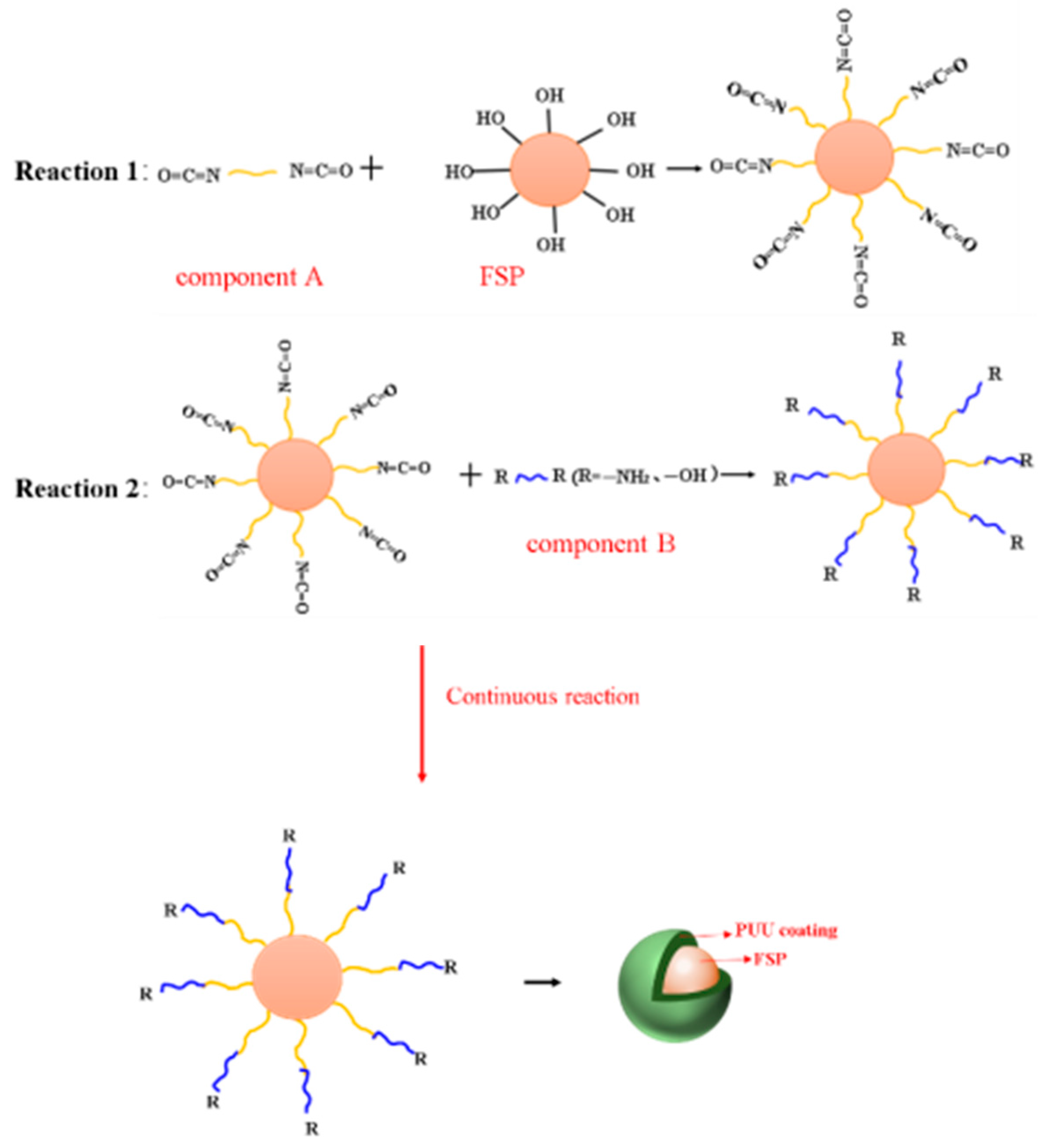
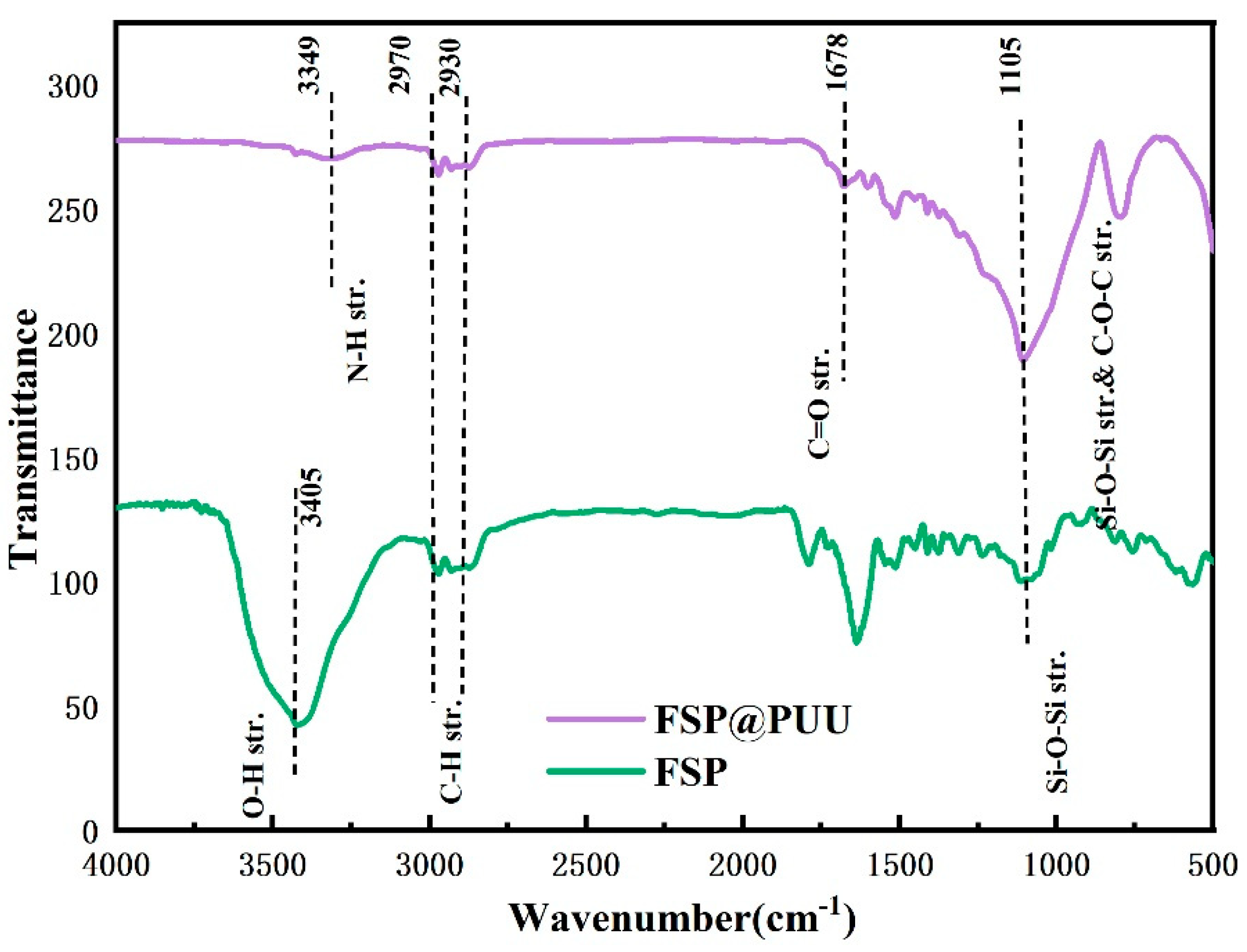
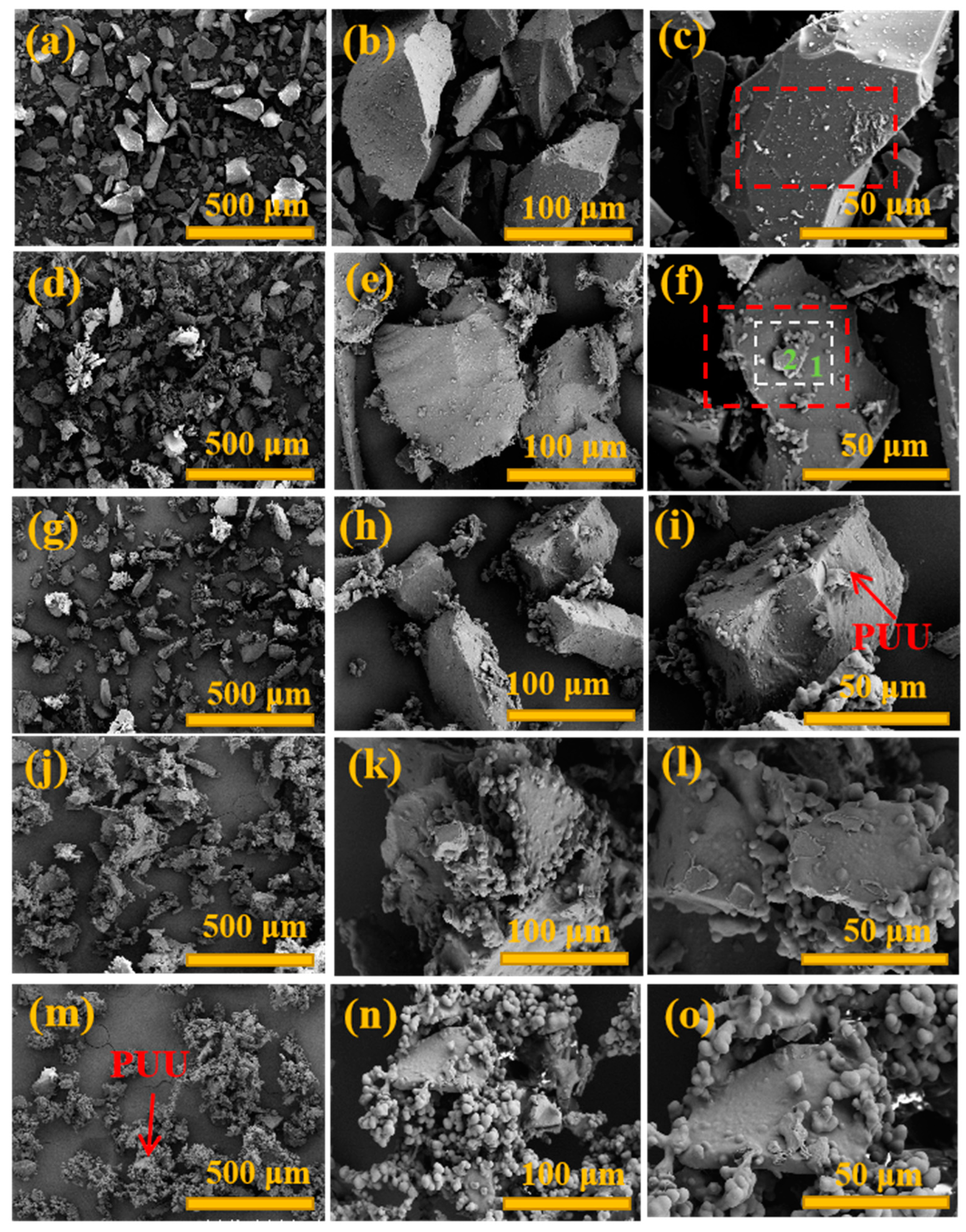

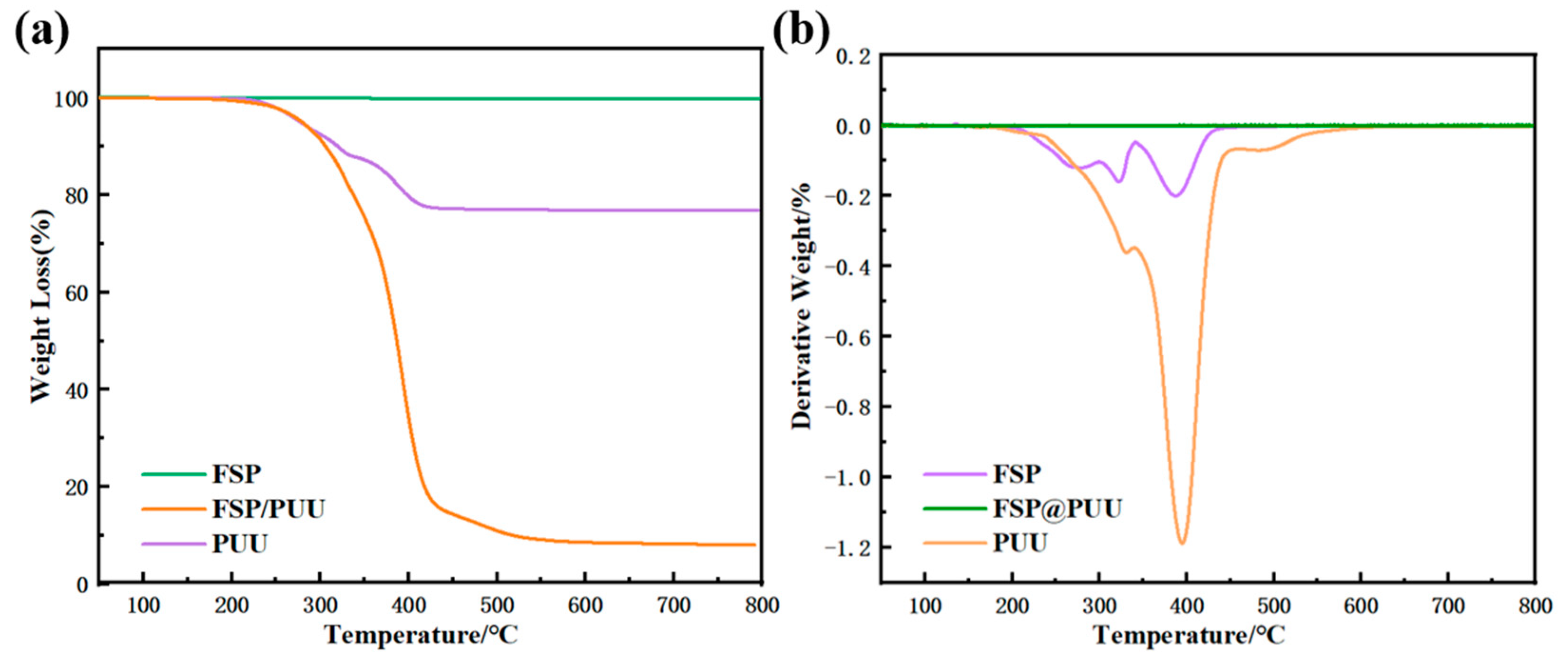


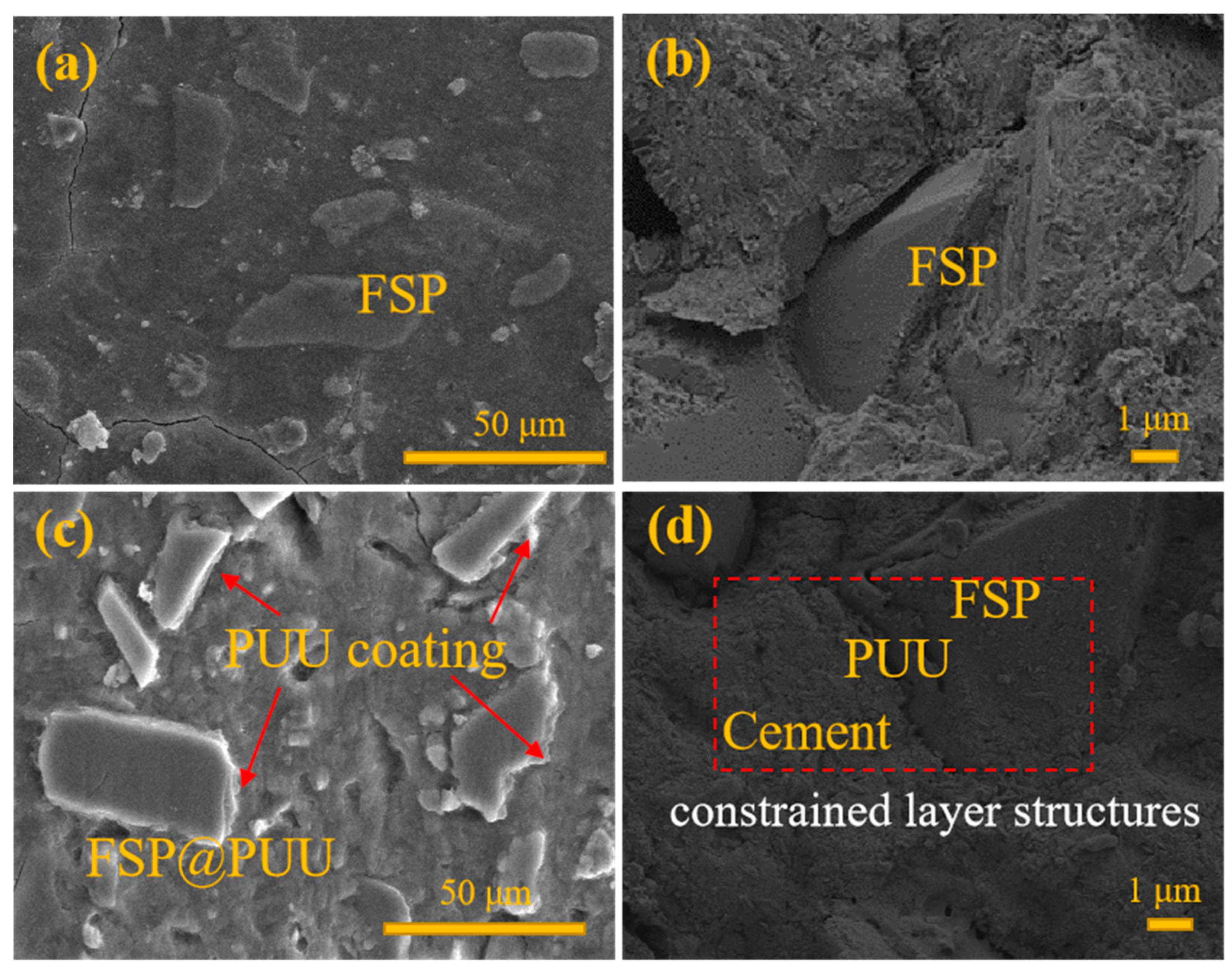
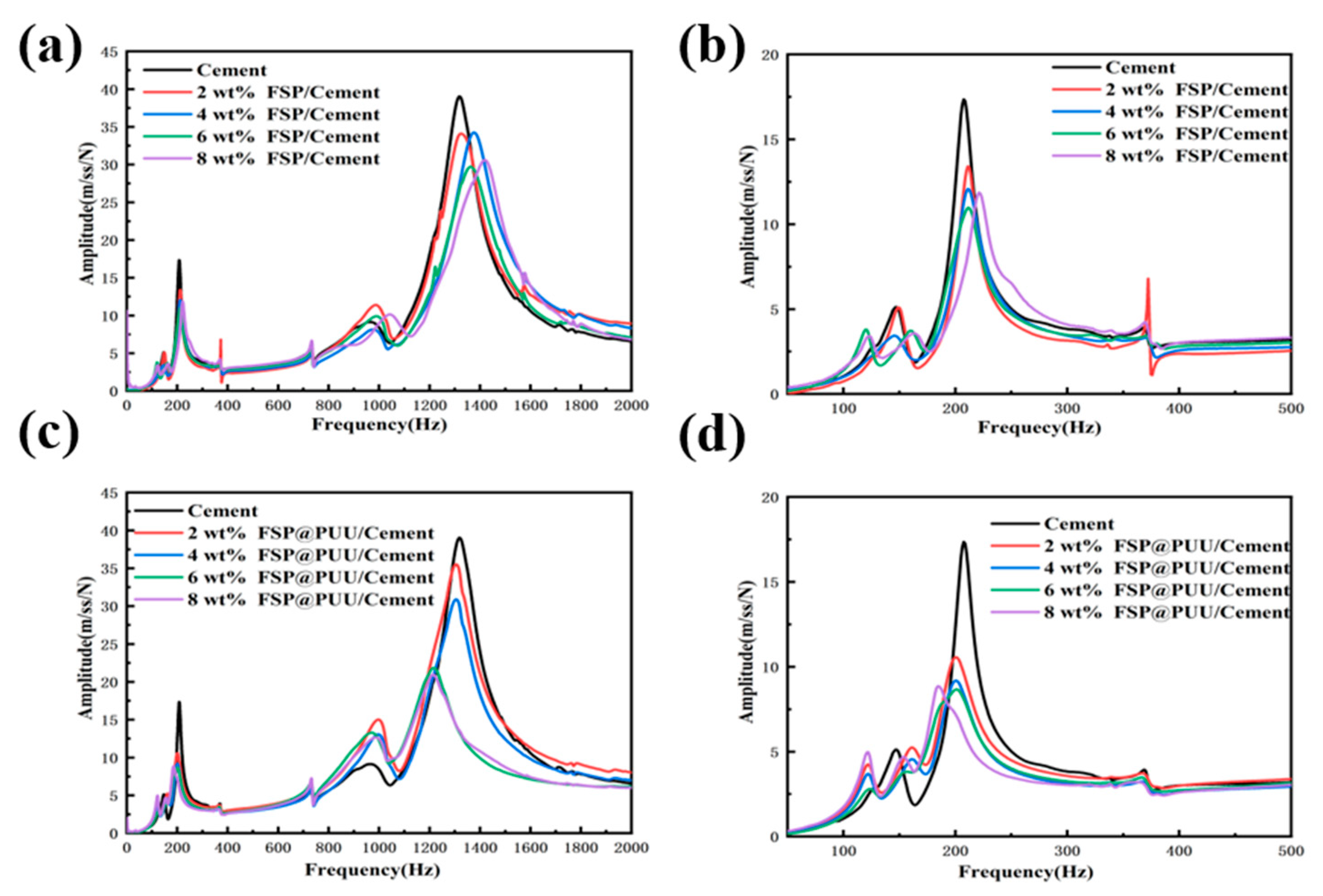
| Composition (wt.%) | SiO2 | Al2O3 | FexOx | CaO | MgO | SO3 | Other |
|---|---|---|---|---|---|---|---|
| Cement | 12.26 | 3.76 | 5.50 | 70.86 | 3.04 | 2.06 | 2.50 |
| FSP | 96.24 | 0.26 | 0.99 | -- | 0.04 | 0.04 | 2.44 |
| Sample | FSP (g) | Component A (g) | Component B (g) |
|---|---|---|---|
| FSP@PUU-1 | 6.50 | 1.71 | 1.55 |
| FSP@PUU-2 | 6.50 | 1.10 | 1.00 |
| FSP@PUU-3 | 6.50 | 0.66 | 0.60 |
| FSP@PUU-4 | 6.50 | 0.56 | 0.51 |
| Specimen | Modal Frequency (Hz) | Damping Ratio (%)(+−5%) | ||
|---|---|---|---|---|
| 1nd | 2nd | 1nd | 2nd | |
| Cement | 207.52 | 1318.36 | 3.59 | 4.61 |
| 2 wt%FSP/Cement | 211.18 | 1324.46 | 3.75 | 5.43 |
| 4 wt%FSP/Cement | 211.18 | 1324.46 | 3.97 | 5.55 |
| 6 wt%FSP/Cement | 211.18 | 1362.30 | 6.40 | 6.63 |
| 8 wt%FSP/Cement | 220.05 | 1418.46 | 4.83 | 6.49 |
| 2 wt%FSP@PUU/Cement | 200.20 | 1304.93 | 6.60 | 4.93 |
| 4 wt%FSP@PUU/Cement | 203.88 | 1321.41 | 7.68 | 5.00 |
| 6 wt%FSP@PUU/Cement | 200.20 | 1220.70 | 8.50 | 5.83 |
| 8 wt%FSP@PUU/Cement | 184.33 | 1220.70 | 8.33 | 6.11 |
Publisher’s Note: MDPI stays neutral with regard to jurisdictional claims in published maps and institutional affiliations. |
© 2022 by the authors. Licensee MDPI, Basel, Switzerland. This article is an open access article distributed under the terms and conditions of the Creative Commons Attribution (CC BY) license (https://creativecommons.org/licenses/by/4.0/).
Share and Cite
Cheng, H.; Yan, P.; Wan, F.; Feng, C.; Zhu, Y.; Lv, P.; Ma, M. Preparation and Evaluation Mechanic Damping Properties of Fused Silica Powder@Polyurethane Urea/Cement Composites. Materials 2022, 15, 4827. https://doi.org/10.3390/ma15144827
Cheng H, Yan P, Wan F, Feng C, Zhu Y, Lv P, Ma M. Preparation and Evaluation Mechanic Damping Properties of Fused Silica Powder@Polyurethane Urea/Cement Composites. Materials. 2022; 15(14):4827. https://doi.org/10.3390/ma15144827
Chicago/Turabian StyleCheng, Hao, Peihui Yan, Fei Wan, Chao Feng, Yunfei Zhu, Ping Lv, and Mingliang Ma. 2022. "Preparation and Evaluation Mechanic Damping Properties of Fused Silica Powder@Polyurethane Urea/Cement Composites" Materials 15, no. 14: 4827. https://doi.org/10.3390/ma15144827
APA StyleCheng, H., Yan, P., Wan, F., Feng, C., Zhu, Y., Lv, P., & Ma, M. (2022). Preparation and Evaluation Mechanic Damping Properties of Fused Silica Powder@Polyurethane Urea/Cement Composites. Materials, 15(14), 4827. https://doi.org/10.3390/ma15144827





